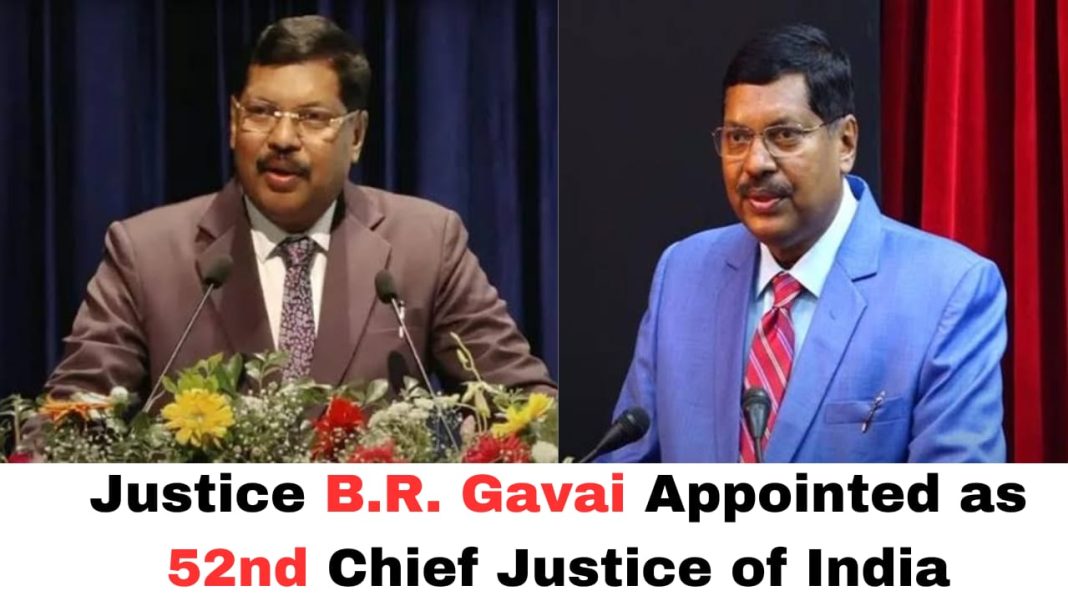Digital News Guru National Desk:
Justice B.R. Gavai to Succeed CJI Sanjiv Khanna on May 14
Justice B.R. Gavai has been appointed as the 52nd Chief Justice of India (CJI), with his tenure set to commence on May 14, 2025.He will succeed the current CJI, Justice Sanjiv Khanna, who is scheduled to retire on May 13, 2025.
A Historic Appointment
Justice Gavai’s elevation is not just a matter of seniority, but a momentous event in the pursuit of diversity, inclusivity, and social representation in India’s apex court. The only previous Dalit to occupy the office of CJI was Justice K.G. Balakrishnan, who served from 2007 to 2010.

His appointment comes at a time when debates around social justice, representation, and caste equity in Indian institutions have gained national prominence. By assuming the top post, Justice Gavai’s tenure will serve as both a symbolic and practical acknowledgment of the need for broader representation in India’s judiciary.
Educational and Legal Background
Born on November 24, 1961, in Amravati, Maharashtra, Justice Gavai holds a law degree from Government Law College, Mumbai. He enrolled as an advocate in 1985 and initially practiced at the Bombay High Court. He was appointed as Assistant Government Pleader and Additional Public Prosecutor in the High Court in 1992, and was later made a permanent judge of the Bombay High Court in November 2003.
Over the years, Justice Gavai has built a reputation for sound legal reasoning, judicial integrity, and a balanced approach to matters of constitutional, criminal, and administrative law. In May 2019, he was elevated to the Supreme Court, where he has served with distinction for six years.
Tenure and Responsibilities
Justice Gavai’s term as Chief Justice will be relatively brief, concluding on November 23, 2025, upon reaching the mandatory retirement age of 65. Despite the short duration, his leadership is anticipated to influence key judicial reforms and uphold the principles of justice and equality.
Appointment Process
The appointment followed the established convention of seniority, wherein the outgoing Chief Justice recommends the next most senior judge of the Supreme Court.Justice Sanjiv Khanna, adhering to this tradition, recommended Justice Gavai for the position.The recommendation was subsequently approved by President Droupadi Murmu.

Legacy and Expectations
Justice Gavai’s appointment is seen as a milestone in promoting inclusivity within the Indian judiciary. His extensive experience and commitment to constitutional values are expected to guide the Supreme Court in addressing contemporary legal challenges and reinforcing public trust in the judicial system.
Symbolism and Social Impact
Justice Gavai’s rise to the top court carries a powerful symbolic message. As someone who comes from a Dalit background, his leadership of the Indian judiciary sends a signal of inclusion in a system historically dominated by members of upper castes. His appointment may inspire greater confidence among marginalized communities in the fairness of the judicial process.
His personal journey from Amravati to the Supreme Court reflects the aspirations of millions of Indians who seek empowerment through education and the rule of law. It also aligns with ongoing conversations about affirmative action, judicial diversity, and the need to dismantle institutional caste hierarchies.
Conclusion
In a significant development for India’s judiciary, Justice Bhushan Ramkrishna Gavai has been appointed as the 51st Chief Justice of India (CJI). He will officially assume office on May 14, 2025, He will succeed the current CJI, Justice Sanjiv Khanna. The appointment marks a historic moment, as Justice Gavai will be only the second Dalit in the nation’s history to hold the highest judicial position in the country.

Justice B.R. Gavai’s appointment as the Chief Justice of India is not just a legal transition but a moment of national significance. It is a testament to the principles of equality, meritocracy, and constitutional justice that form the bedrock of Indian democracy.
As he prepares to lead the country’s highest court, all eyes will be on how he navigates the responsibilities of his office and addresses the challenges facing the judiciary. His success will not only be measured by the judgments he delivers but also by the legacy of fairness, accessibility, and inclusion he leaves behind.
You May Also Read: WAVES 2025 Summit: PM Modi Announces Rs 4,000 Crore for Creative Technologies Institute








